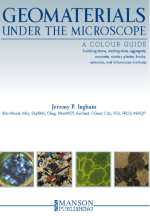Добрый день, Коллеги. Важное сообщение, просьба принять участие. Музей Ферсмана ищет помощь для реставрационных работ в помещении. Подробности по ссылке
Geomaterials under the microscope A colour guide. Building stone, roofing slate, aggregate, concrete, mortar, plaster, bricks, ceramics, and bituminous mixtures / Геоматериалы под микроскопом. Цветное руководство
Geomaterials are defined as ‘processed or unprocessed soils, rocks or minerals used in the construction of buildings or structures, including man-made construction materials manufactured from soils, rocks or minerals’ (Fookes, 1991). The definition deliberately includes manmade materials such as bricks or cement but excludes allied engineering materials whose manufacturing is more extensive, such as steel and synthetic paints.
Geologically derived materials have been used in construction for much of human history and, being geologically common, are available worldwide. Strong rocks provide dimension stone for masonry, cladding, and flooring, while thinly bedded or cleavable rocks are suitable for roofing. Limestone can be calcined to produce lime or cement, which can be mixed with sand and water to make mortar for bonding masonry units. Gypsum is heated to produce plaster and plasterboard. Large stone blocks are used as armourstone protection for coastlines and riverbanks. Aggregates from crushed rock are used for roadstone, either loose or in layers bound by bitumen, as macadam and asphalt. Both crushed rock and natural gravel aggregates are mixed with Portland cement and water to produce concrete. Aggregates of all origins are used as fill materials for earthworks. Pure silica sands are melted and cast into glass for windows and other architectural elements. Clay soils can be used to make sundried or kiln-fired bricks for masonry construction, architectural terracotta, and ceramic tiles. Figure 1 provides a summary of the main resources used for bulk construction, showing the links between the various raw materials, the finished products, and their uses. <...>




